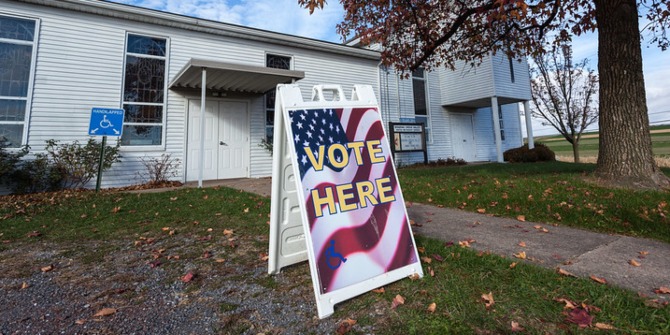 In the 2022 midterms, the Keystone State appears poised, as ever, to play a bellwether role. Following primary contests in the state, Maxwell Serota and Robin Kolodny write that Pennsylvania’s US Senate, House and gubernatorial elections are likely to be highly contested – and incredibly important nationally – this November.
In the 2022 midterms, the Keystone State appears poised, as ever, to play a bellwether role. Following primary contests in the state, Maxwell Serota and Robin Kolodny write that Pennsylvania’s US Senate, House and gubernatorial elections are likely to be highly contested – and incredibly important nationally – this November.
- Looking ahead to elections across the US in 2022, our mini-series, ‘The 2022 midterms‘, explores aspects of elections at the presidential, Senate, House of Representative and state levels, and also reflects on what the results will mean for US politics moving forward. If you are interested in contributing, please contact Rob Ledger (ledger@em.uni-frankfurt.de) or Peter Finn (p.finn@kingston.ac.uk).
Pennsylvania is a critical battleground state in the upcoming 2022 midterm elections. In the 2020 presidential election, Democratic candidate Joe Biden managed to carry the state by just over one percent. The 2022 senate and gubernatorial midterm elections in the state are shaping up to be just as close. Pennsylvania is one of the only states in America represented by senators of both parties and has frequently switched from its partisan lean from election to election over the last century. The state is also one of the best chances Democrats have to flip a Republican seat in the US Senate and the race for governor has been called “the most important election this year in America.”
Primaries
The Pennsylvania primaries were held on Tuesday, May 17, 2022. In the Republican Senate primary doctor, businessman, and television personality Mehemet Oz was nominated as the candidate after a long, heated primary. Trump-endorsed Oz defeated David McCormick, his chief opponent, by 951 votes out of 1.3 million cast. The race was so tight, an automatic recount was triggered, delaying results by almost a week. McCormick conceded the race to Oz and both candidates pledged to work to unite the party for the general election.
The Democratic senate primary was far less contentious. Lieutenant Governor John Fetterman defeated Conor Lamb, a US congressman from Pennsylvania’s 17th congressional district, and Malcolm Kenyatta, a state representative from Philadelphia. Fetterman cruised to victory with a margin of more than thirty points, winning every county in Pennsylvania. Fetterman’s decisive victory was blunted slightly by a stroke he suffered on May 13, just days before the primary, which prevented him from appearing publicly to celebrate his victory.
The gubernatorial primaries in Pennsylvania were less competitive. Democratic candidate Josh Shapiro ran unopposed in the gubernatorial primary, while the GOP primary had a crowded field of nine candidates. State senator Doug Mastriano won the Republican nomination with 43.8 percent of the vote. The Shapiro campaign seemingly anticipated Mastriano’s victory, running attack ads against Mastriano during the primary that called him “one of Donald Trump’s strongest supporters.”
The Senate race in November
The Pennsylvanian senate election is one of only six open senate seats in the 2022 election cycle. In 2020, incumbent Republican senator Pat Toomey announced he would not be seeking reelection. Toomey was elected by slim margins both in 2016 (+1/5 percent) and in 2010 (+2.0 percent), demonstrating the state’s competitiveness.
The candidates in the general election are both unconventional, spurring intense national interest in the race. John Fetterman is the state’s current Lieutenant Governor, a position he won partly from his failed 2016 campaign for the Democratic US Senate primary (Katie McGinty was the winner who then narrowly lost to Pat Toomey). Fetterman is a liberal who supported the presidential candidacy of Bernie Sanders. He supports Medicare for all, a $15 minimum wage, and the legalization of cannabis. Fetterman served as mayor of Braddock, a small steel town in rural Pennsylvania for 13 years. Fetterman does not look like a typical politician; instead, the 6’9” man sports a shaved head and goatee and is often found wearing basketball shorts and a sweatshirt in lieu of a suit. He connects with some of the same white working-class voters in the state that Trump did. While some Democrats worry that Fetterman is too liberal to win in Pennsylvania, others hope that his apparent ability to connect with blue collar workers across the state will help make inroads in counties that Trump carried by a large margin in the 2020 election.
Dr. Mehmet Oz, a heart surgeon, businessman, and television personality faces Fetterman. Oz initially rose to fame as a health expert on “the Oprah Winfrey Show” and later as the host of “the Dr. Oz Show” where he received criticism for dispensing sometimes-unsound medical advice. Oz is a standard Republican candidate on the issues. He pledges support for the Second Amendment, small businesses, veterans, and tax cuts. Oz recently moved to Pennsylvania from New Jersey to run for the Senate seat, prompting the Fetterman campaign to attack Oz as a carpetbagger with a series of tweets, ads, and other media including yard signs reading “Oz for New Jersey.” Currently, Fetterman leads most polls against Oz but both campaigns expect the gap to tighten as election day nears.

“20131105-092315” (CC BY-NC 2.0) by weaverphoto
A high stakes Governor’s race
The Pennsylvania gubernatorial election is also a contest for an open seat as Democratic Governor Tom Wolf has served both terms of a two-term maximum. Winning the governorship would allow the Republican Party, which already controls both houses of the state’s legislature, to pass legislation unhindered by Democratic opposition. For Democrats, winning the race is essential to prevent the very trifecta that Republicans seek. The stakes of the race have been raised further by the Dobbs v. Jackson Supreme Court decision in June of 2022 that ended constitutional protection for abortion and returned the decision of its legality to the states. The Republican-controlled Pennsylvanian state legislature is hostile to abortion rights. In early July they advanced a potential amendment that would allow them to restrict abortion in the future and it is likely that they would restrict abortion if they won the governorship.
The Democratic candidate for governor is the state’s Attorney General Josh Shapiro. Shapiro has been involved in Pennsylvania politics since 2005 when he was first elected to the state’s House of Representatives. Shapiro is a typical Democrat and his policies—support for abortion, clean energy, and criminal justice reform—are in line with national party politics as well. He worked very hard to clear the primary field for himself, a feat unprecedented in Pennsylvania politics.
Unlike Shapiro, Republican candidate Doug Mastriano is new to politics. After nearly 30 years in the US Army, Mastriano ran unsuccessfully in a Republican primary for a congressional seat in 2018, then successfully in a special election for the State Senate in 2019, to which he was reelected in 2020. Mastriano has been called a “Christian nationalist” by various newspapers across the state, although he has rejected the label. Mastriano embraced and perpetuated Donald Trump’s conspiracy theory that the 2020 presidential election was stolen, going as far as bussing Trump supporters to the capitol on January 6, 2021, and crossing police barricades there himself. He is such an extreme candidate that several republican politicians from Pennsylvania broke party lines and endorsed Shapiro, arguing Mastriano was a threat to the rule of law. Despite Mastriano’s extremism, Shapiro has only a marginal lead in several recent polls.
The US House of Representatives from Pennsylvania
From 2012 to 2020, Pennsylvania had 18 representatives to the US House. In 2017, a major judicial victory was won by reformers who argued that the state, with 51 percent Democratic voter registration, had been inappropriately gerrymandered by party. At that point, the split of the House delegation was 13 Republicans to five Democrats. After a protracted battle for a new map for the 2018 elections, both the Republicans and the Democrats each held nine seats.
Because of reapportionment after the 2020 census, Pennsylvania lost one seat. In 2022, only 17 members will be elected with a map that slightly favors Republicans. Political observers agree that in 2022, the Democrats are likely to win six seats, the Republicans eight, with three seats rated as toss-ups.
At every level, Pennsylvania embodies the current political divisions seen in the nation at large.
Please read our comments policy before commenting.
Note: This article gives the views of the authors, and not the position of USAPP – American Politics and Policy, nor the London School of Economics.
Shortened URL for this post: https://bit.ly/3A3w91Q
About the authors
 Robin Kolodny – Temple University
Robin Kolodny – Temple University
Robin Kolodny is a professor and chair of the department of Political Science at Temple University. She was a 2008-2009 Fulbright Distinguished Scholar to the United Kingdom at the University of Sussex. In 1995, she was an American Political Science Association Congressional Fellow. She is the author of Pursuing Majorities: Congressional Campaign Committees in American Politics.
Maxwell Serota – Carleton College
Maxwell Serota is an undergraduate student at Carleton College




